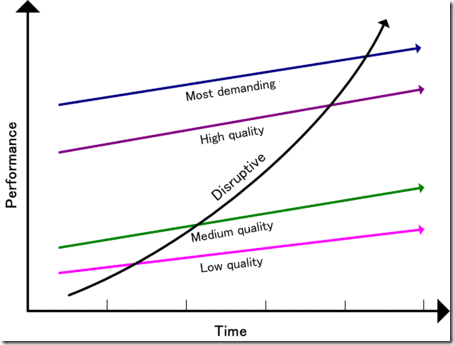Related to disruptive innovation, Vivian Giang wrote today in Business Insider’s Careers section, a piece called: “A Bunch Of Young Lawyers Are Suing Their Law Schools Because They Don’t Have Jobs.” The story goes on to say that about 75 alumni have filed class action suits accusing law schools of inflating employment and salary data to attract prospective students. These suits seek “$200 million in damages for fraud, negligent misrepresentation, and violations of business law.” Clearly, the implication here is that the class action suits are claiming false advertising. No doubt, the institutions will claim that the economy, or the students themselves, are to blame.
Disruptive Innovation or Concern
I have a tax-payer and parent’s interest in highlighting the value of higher education (or lack of it), the need for more disruptive innovation in academia’s business models, and potential shift in economic supply and demand that could result overall for the business of public higher education.
Complacency, Mediocrity & Catastrophe
Why not have a healthy dose of disruptive innovation in the business of academia? Of course, the death of innovation is traditional institutionalized and formulaic thinking, doing things the same old way, decade after decade with an “it ain’t broke, so don’t fix it” mindset.
Institutionalized thinking breeds organizational mediocrity, a culture of complacency and operational inefficiency – and uninteresting performance. I learned this in business school! The net result is typically losing track of who the customer is and how to competitively serve their needs and expectations. Reminder: the customer is the student and parents writing tuition checks. Like a stagnating business, academia becomes an “internally focused product-centric” organization, not an “external market-need focused and customer-centric” organization. Lacking an external check and balance to ensure that the customer needs haven’t changed, or another of Porter’s Five Forces has not shifted the market (e.g., for-profit education), the problem continues unrecognized and becomes pervasive in a dangerous sense.
It takes a catastrophic event to highlight this issue, like state budget cuts, economic recession, drop in enrollment, or a lawsuit to initiate innovation in this climate of complacent mediocrity. Unfortunately, the same kind of catastrophic event that could drive disruptive innovation, is equally likely to drive downsizing, operational cuts, budget realignments and so on. The host of make-work to address superficial symptoms is usually accompanied by consuming politics and organizational noise that can mask the root cause and thereby prevent creating a disruptively innovative solution.
Irony & Law
Design thinking and disruptive innovation is taught in business schools like Harvard, MIT, Northwestern, Stanford, et. al. Why hasn’t this kind of thinking been visibly put into practice in the very world of academia that teaches it? Could business schools be the target of the next class action lawsuit like the one Vivian Giang wrote about today in Business Insider for law schools? Only this time, could the context be more than just false advertising of opportunity and be targeted directly at the very core of the curriculum? I.e., a lawsuit that says Business Schools should be run like Businesses – put the proverbial learning on disruptive innovation, organization, customer-centric business models, and value delivery taught in the classroom, to work directly in the business school’s own organization? Would this generate programs like:
- Put dean’s to the same tests that we put CEOs for building learning organizations.
- Initiate human resources programs and customer satisfaction surveys over the long-term with student and parent 360-degree feedback programs.
- Base loyalty not on alumni socializing events, but on long-term value generated for students from the education received.
Disruptive innovation is not easy – it requires a culture that nurtures it and a leader that defends it from the top. If an organization stagnates and breeds a culture of mediocrity, empower boards of trustees to make changes. If they don’t, won’t or can’t, fortify the bench-strength by replacing trustees.
Something To Ponder
Should administrators and tenured or endowed professors be above the same level of accountability for institutionalizing an academic culture of disruptive innovation similar to that which (they) business schools teach students in their ethics courses?
Does anyone else see the irony in general of business schools teaching these concepts, but not applying them to the public colleges of business visibly, rigorously and openly?
What do you think?
IMAGE SOURCE: Wikimedia Commons (adapted).










